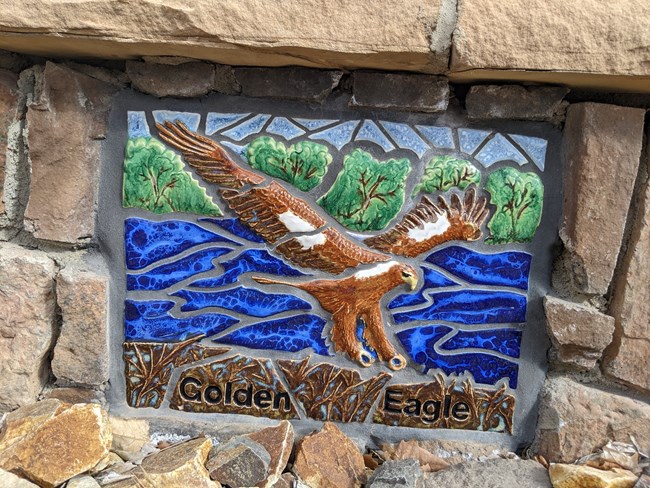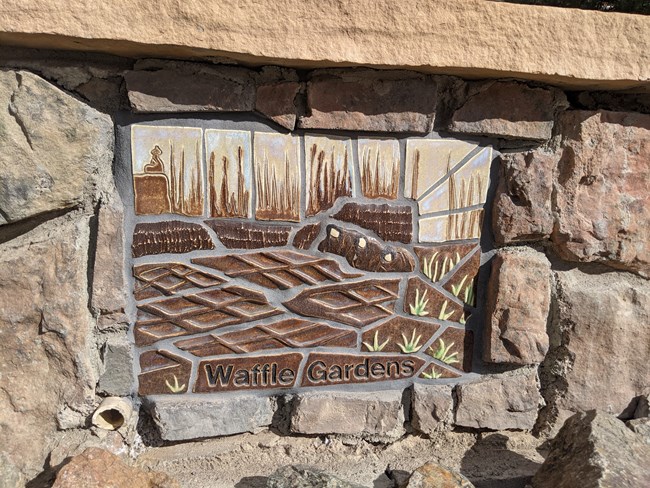Last updated: August 9, 2022
Article
Martineztown Mosaics
The mosaics on the wall up to the “high road” represent the animals and landmarks travelers may have seen as they traveled the 1600 miles on El Camino Real de Tierra Adentro. As you walk along the path, look for the twelve art pieces. Cassandra Reid and the Apprenticeships for Leaders in Mosaic Arts, or ALMA, designed and installed the tile art using traditional handmade mosaic techniques.

NPS Photo
Jaguar
Jaguar, or panther, the big cat of the Americas. This near threatened species used to be seen in environments throughout what is now southern Arizona to northern Argentina. The trail travelers had to be cautious of this nocturnal predator; it could prey on their livestock and burros if they didn’t keep a close eye on them! You shouldn’t see any on your walk today.

NPS Photo
Peña de Bernal
Volcanic neck or monolith in San Sebastián Bernal, Querétaro, México. Rising 1,150 ft above the surrounding landscape, it is one of the tallest monoliths in the world! At over 8,000 ft above sea level, it can be seen from almost every town in Querétaro. It was a landmark passed by travelers on El Camino.

NPS Photo
Golden Eagle
This large raptor is an important symbol for both Mexico and the State of New Mexico. In the Aztec origin myth for Tenochtitlan, modern-day Mexico City, the Aztecs knew where to establish the new town when they saw an eagle perched on top of a cactus eating a snake, as prophesized by the sun god, Huitzilopochtli, as the site of their new civilization.

NPS Photo
Mexican Kingsnake
Red, brown, and tan snake found in a wide range of environments throughout northeastern Mexico. They are nonvenomous and are ophiophagous, or “snake eaters” and will eat venomous snakes like rattlesnakes.

NPS Photo
Zacatecas Silver Mine
Silver mine opened by the Spanish in the 16th century. The extraction and export of silver from the mine grew the wealth of Zacatecas and funded trade and travel on El Camino Real.
NPS Photo
Desert Bighorn Sheep
These animals are well adapted to their desert homes. They are incredible climbers; their hooves allow them to run up steep cliffs away from predators. They are very social animals, often living in herds of about a dozen individuals. The males, called rams, usually live separate from the female ewes and young lambs. Both rams and ewes will grow one set of horns throughout their lives. The horns are made of keratin, same as your fingernails! Male horns grow significantly larger than female horns. Rams will face off, butting heads or locking horns to assert their dominant physical prowess to others in the social group and potential mates.

NPS Photo
San Elizario Chapel
Spanish Colonial style church which served the soldiers of the nearby presidio who protected the settlement and caravans from Apache raiders. Named for French Saint Elzear, patron saint of soldiers. The presidio was established in 1788 by the Spanish Government to protect trade and travel along the royal road through New Spain. San Elizario chapel was added to the settlement about forty years later.
The Chapel is still part of the active perish in San Elizario, Texas.
Learn more about the Presidio Chapel on our website.

NPS Photo
Sandhill Crane
Large and impressive gray aquatic birds who travel in great numbers during migration. They will forage on prairies and in shallow water for grains and small invertebrates. They take to the sky together, hundreds of birds together. They migrate and winter in the southern U.S. and Northern Mexico. They use marshes, wetlands and riparian zones for feeding and nesting. The sandhill crane is also known for their elaborate dance display mating ritual.

NPS Photo
Waffle Garden
Traditional Puebloan gardening method, attributed to the Zuni Pueblo, in which grid plots of soil are framed with short clay or mud retaining walls that help block dry winds and retain moisture in an arid climate.
NPS Photo
Pronghorn
They can run up to 60 miles per hour to evade predators! But you won’t catch them jumping hurtles. They aren’t into jumping much; instead they will walk long distances along fences until they find an opening. Their modern migration is challenged by fences placed across properties in the Southwestern States. Both males and females have horns which they shed annually. Wait, shed horns? That’s right--they are the only ungulate that lose their horns annually!

NPS Photo
Rio Grande Cutthroat Trout
Trout native to the rivers of New Mexico and Southern Colorado. This trout is a threatened species; conservation efforts are ongoing to bring it back from the brink of extinction.
NPS Photo
Steller's Jay
This clever and beautiful blue-and-black bird is found chirping in pine trees throughout the southwest. It perches on a conifer branch in the mosaic. They forage mostly in trees but will also forage in lower trees or on the ground. They feed on seeds and acorns, opening hard shells by pounding on them with their bills.
